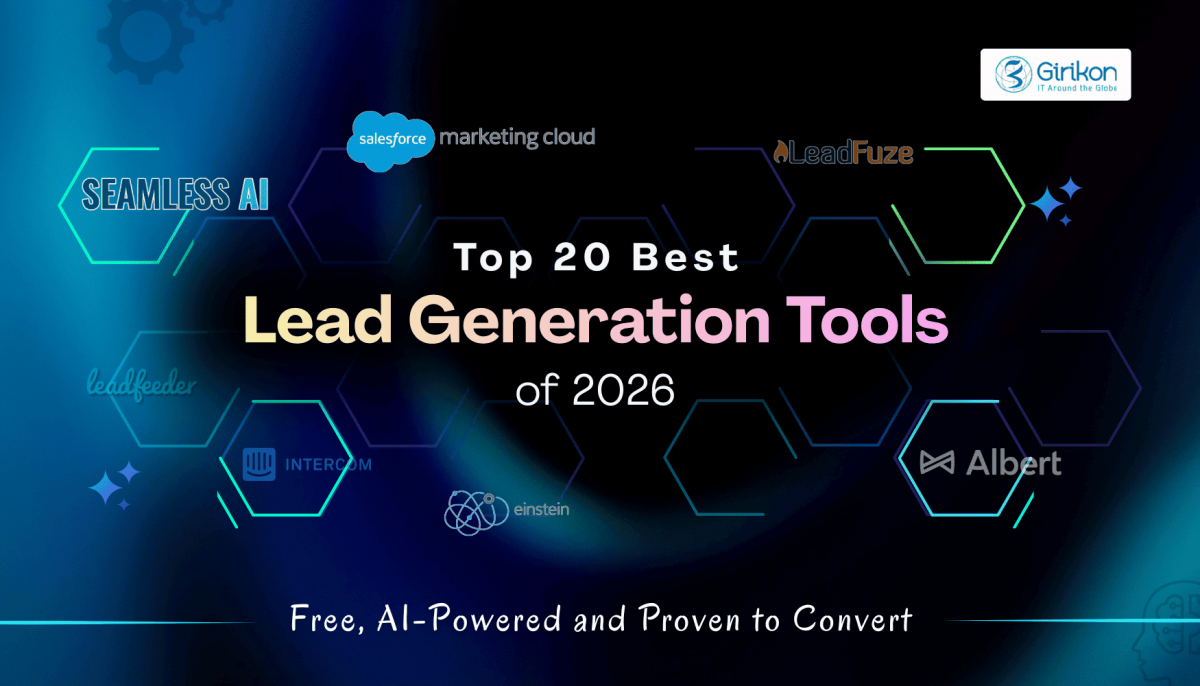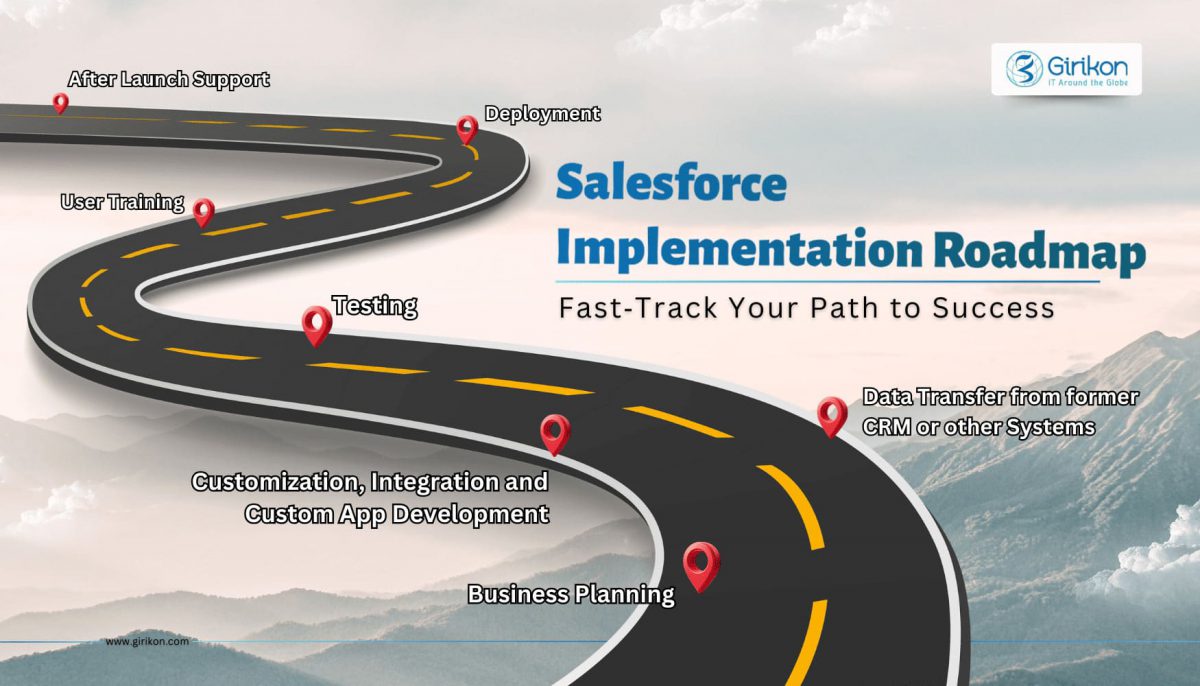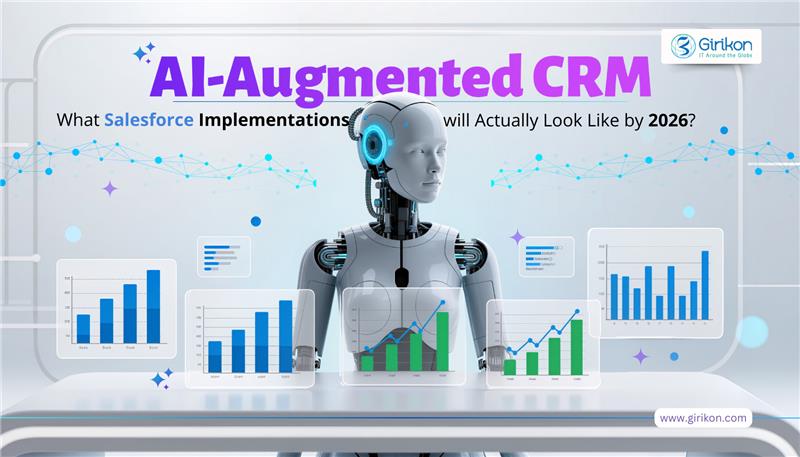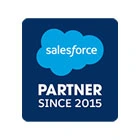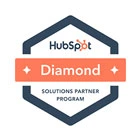Effective communication is key to success in the dynamic world of business. An organization's ability to interact with its customers can make or break its business, whether it's through customized service, order updates, or knowledge of the newest offerings. Customers are constantly looking for an omnichannel experience that is both personalized and seamless. Flyers and emails, which were once the mainstays of communication, are no longer sufficient. Consumers require two-way, real-time interactions, which is where a Salesforce SMS app comes into play.
For this reason, the SMS apps, that seamlessly integrate with your existing CRM, have become a potent instrument in business communication, revolutionizing the way companies interact with their customers.
5 Reasons You Need SMS for Salesforce
SMS for Salesforce can greatly improve your company's operations and offers several advantages. This integration's primary driver is its unmatched customer-facing efficiency and efficacy.
Here are 5 benefits of integrating SMS with Salesforce.
Real-Time Communication
Businesses can offer real-time customer support by utilizing SMS for Salesforce. For example, logistics providers can use SMS to quickly notify customers about delivery locations. Additionally, they can update customers in real-time via SMS about their appointments, keeping them informed throughout their engagement journey.
SMS has an extremely high open rate (over 95% within the first 3 minutes of delivery). With a much higher open rate than emails, SMS is a more effective medium for increasing marketing engagement when using Salesforce.
Higher Efficiency with Automation
By automating processes like order updates and appointment reminders, workflow automation can be streamlined when SMS and Salesforce are integrated. As a result, less manual labor is required, increasing productivity. This allows businesses to shift their attention from regular tasks to strategic ones.
Moreover, it enables you to schedule texts in response to customer behaviour or sales phases, optimizing processes and increasing productivity.
Increased Open Rates and Response Rates
SMS messages have a response rate of roughly 45%, which is significantly higher than other methods of communication. They are excellent for eliciting replies since they are precise and reach out to people immediately. Sales and marketing teams can interact with their audience more successfully as a result.
Retail establishments, for instance, can send out discount codes by SMS to get a quick response from customers. Additionally, they can employ SMS for important notifications to drive efficient and quick customer service.
Personalized Messages to Customers
Businesses can personalize their communications by integrating SMS with Salesforce. They can craft messages that speak to the specific needs and pain points of the audience, which is crucial for building a strong rapport and increasing conversions.
For example, a travel company can provide personalized vacation suggestions based on past reservations. Similarly, financial advisors can provide detailed client-specific investment updates and advice over text.
Tracking and Analytics
Salesforce also needs SMS because of its ability to monitor and evaluate customer interaction and campaign efficacy. Marketing teams can fine-tune their messaging strategies by analyzing open rates, click-through rates, and conversions from SMS campaigns thanks to SMS integration with Salesforce.
In order to increase customer satisfaction and service efficiency, customer support teams can also assess response times and resolution rates via SMS exchanges.
How Do You Send SMS from Salesforce?
You will need more than just the regular Sales Cloud or Service Cloud license in order to send and receive texts using Salesforce. You can extend your functionality further with third-party SMS tools and apps. These are your options.
Use Salesforce’s in-built SMS messaging products
Salesforce has two add-on products for SMS: Mobile Studio and Digital Engagement.
The primary difference between the two is that while Mobile Studio offers SMS marketing features designed to work with other marketing channels in your strategy, Digital Engagement focuses more on customer support interactions. Here are some further significant differences between the two Salesforce products:
Digital Engagement: Digital Engagement is available for $75 per user each month and offers web chats, one-on-one interactions, and automated SMS. There is a cap on the number of conversations you can start each month, however, users can send an unlimited number of messages within a single chat (within 24 hours).
Mobile Studio: The whole Marketing Cloud Engagement solution must be purchased in order to access Mobile Studio. This will enable you to use the messaging features of Mobile Studio. SMS can be included as a touchpoint in multichannel customer journeys with Journey Builder.
Both Salesforce products entail additional costs and have a limited feature set. Additionally, setup can be challenging because you have to go through an authorization or new number request process, which can sometimes take weeks to be approved.
Build a custom solution
You can use Salesforce API or another API provider to build a completely unique texting solution for your Salesforce organization if you'd like greater freedom. Your business or organization can develop any features you require and avoid paying for an extra Salesforce SMS solution by creating a custom integration. This solution, however, comes with a significant implementation and development cost and can be complicated and time-consuming.
Use a 100% Salesforce native app
Using a solution designed specifically for SMS and Salesforce is your best bet. You can find a range of apps designed especially for texting from Salesforce on the Salesforce AppExchange, which caters to the needs of companies just like yours.
In contrast to third-party integrations and add-on products, these native Salesforce SMS applications offer several key benefits:
Lower development expenses
More functionality
Easier to set up and use
Save time on implementation
In addition to these benefits, the app team's experienced customer support team will be at your disposal. All things considered, your team will save money and time by implementing a Salesforce native application.
Best Practices for SMS from Salesforce
Should modern-day businesses text their customers? Of course. SMS boasts of an open rate of 98%. Not only that, it also has an impressive response rate of 45%. Furthermore, nine out of ten text messages are read in a matter of seconds and are answered in a span of three to four minutes. Do these engagement rates imply that companies should have unrestricted texting policies? Not even in the slightest! You don't want your closest friends and relatives to text you at all hours of the day or night, right? Think about your relationships with them. So, the key question is, how should a business interact with its customers via text messaging?
Acquire explicit consent from your audience
Acts protecting consumer data privacy are very important. The regulations clearly outline the penalties for breaking the GDPR, which can amount to up to 20 million euros or 4% of the offending company's global annual revenue, whichever is larger. The CCPA also lays down the consequences of violations. Once the initial opt-in time limit has passed, make sure you automate the re-opt-in procedure and obtain consent once more.
Consider your recipient’s time zones
Avoid being that organization that texts customers at two in the morning when they are most likely asleep. Make sure the timing of your texts is aligned with your recipient's time zone. When sending texts, stick to the regular business hours of the recipient's time zone.
Maintain cadence in your texting
Make sure to stay in touch with your audience on a regular basis; you don't want them to forget who you are. A word of caution here to avoid undesirable effects. Make sure the texts you send are insightful or offer something of value. People may become disinterested in hearing from you if you communicate too much, which could lead to a spike in unsubscribe rates. A person's day might easily become unnecessarily stressful from receiving too many texts.
Be consistent.
Maintain the same number when texting your recipient. This will enable them to recognize the message as coming from you, and even if they haven't read it yet, they will recognize its significance. When you consistently provide messages on topics that matter to your customers, from the same number, they will come to trust you and your business.
Stay engaged in the conversation.
Effective communication is always reciprocal in nature. When customers reply to your messages, make sure you answer promptly and politely. Make sure you respond to inquiries precisely and completely. To make your points clearer, include citations and links to your sources. All of that gives your customers a growth-oriented learning experience.
Delight your customers.
Reward your customers when you see them doing something outstanding with a wonderful text message. If you can, follow up with a surprise package or something meaningful. For instance, call out your customer and make a donation to their favorite charity in their honor if they recently wrote a blog about taking part in an activity that improved the lives of others.
Impress upon your customers that they might miss out on something big.
The fear of missing out is the best engagement tool available. Your customers will be all in for the next big thing if you can make them believe they are going to miss something important or that they have already missed something important. Announcements, events, and participation opportunities are all excellent places to start when trying to create the fear of missing out.
Don’t overdo your messaging.
Who would actually want to talk to someone who is constantly attempting to upsell them something? Even while increasing sales may be the goal of your text marketing, keep in mind that the person receiving the message is a real person. Be conversational and avoid coming across as pushy.
Focus on the call to action.
In the end, you want to start a dialogue with the customer that will lead to the next phases of an engagement. Make sure the customer is encouraged to continue their experience with your business in the text message. Notifications such as “Free trial on registration”, “Enter code DEAL15 at checkout!”, or “Fill out this survey to be eligible for a free gift voucher!” are quite helpful.
Give people the option to opt-out with every message.
The consequences of texting those who haven't opted in have already been discussed. Likewise, failing to provide recipients with an unsubscribe option is illegal, so make sure that every message you send says something along the lines of "Text STOP if you wish to opt out of future messaging."
What are you waiting for? Set up a call with the GirikSMS team right now and get a free 30-day trial of a 100% native Salesforce texting app.
Engaging with customers on the channel of their preference is key to establishing a connection with them. An intriguing statistic is that 35% of customers prefer receiving marketing communications via mobile platforms. If anything, it serves as a gentle reminder to businesses to think about utilizing SMS for business-related communications.
Many businesses currently engage in this, particularly on high-volume shopping occasions like Black Friday. However, there are plenty of additional ways to use SMS to interact with your customers all year long besides the typical peak seasons.
Let's look at a few strategies for using SMS to improve business communication throughout the year.
What is SMS in business communication?
The term 'SMS for business communication' refers to how businesses utilize text messaging to communicate with customers, convey critical information, promote products and services, and improve their overall communication.
SMS-based business communication utilizes a software program rather than a specific person to communicate with people via text. This method, referred to as application-to-person (A2P) SMS, method opens up a world of possibilities.
Consider a hotel as an example. To boost guest satisfaction, hotels could quickly text them to confirm their reservation. Alternatively, a doctor could notify a patient via SMS with pertinent information following a visit. Even though these communications are only being received by one individual, they are not from multiple people.
Bulk SMS messages are also relevant. A retailer might send out a bulk SMS message to subscribers promoting a new product or providing a time-limited coupon.
It's also important to remember that companies can communicate with customers via more than just text messages. They may also send audio files, graphics, photos, videos, and other types of multimedia via Multimedia Messaging Service (MMS) messaging.
Benefits of SMS for business communication
As we've already indicated, a significant portion of your target market will prefer SMS correspondence. Here are four more advantages of employing SMS business messaging in addition to simply keeping your customers happy:
Messages are read almost instantly
SMS has an impressively high open rate and, even better, messages get read by most people fairly quickly.
You can send business SMS with confidence knowing that a significant portion of your subscribers will not only see your message but will see it within a few minutes of receiving it. Because SMS can reach your target demographic much faster than social media or email, it works incredibly well for time-sensitive campaigns such as flash sales.
SMS has a wide reach
To put it simply, text messaging is available to everyone who owns a mobile phone. Consider this: SMS messaging can be used to communicate with over 7.2 billion people worldwide. SMS has an unparalleled reach!
SMS messaging doesn’t require an internet connection
SMS is compatible with any mobile device that has a mobile network connection. That's because SMS messaging doesn't require an internet data plan, it works on mobile network technology.
While the proliferation of smartphones shows no signs of stopping, SMS allows users to receive messages on any kind of mobile phone, so you can reach a far wider audience with it than you could with internet-based approaches.
Messages can be automated
When it comes to managing repetitive tasks, automation is invaluable, and customers can also see its value. Consider this: regular SMS communications, such as delivery notifications, order confirmations, and password verifications, can be automated. Employees can rest easy knowing they don't have to perform these mundane customer service tasks manually once solutions like these are up and running. As an added bonus, you can use SMS templates to further streamline your communications.
Ways to use SMS for business communications
Here are seven ways to get started if you're ready to start reaching out to more prospects and customers via text messaging, which is how people like to be contacted by your business.
Marketing campaigns
SMS has an inherent limitation of 160 characters. There are two primary ways to use SMS for marketing.
Individual texts with a clear call to action.
A series of SMS messages that, typically over a few days or weeks, provide targeted offers or information to a particular segment of subscribers.
Whatever method you choose, the most important thing is to make it easy and convenient to respond. Usually, this means providing a web link. That page can be a special campaign page that lets you monitor the response rate with ease. It might also be an already-existing page, such as a category or product page.
Effective SMS marketing strategies cover the following:
Promote flash sales
Launch new products
Revive older products that have been improved upon or updated.
Run time-limited promotions
Offer loyalty members exclusive deals; target certain subscriber categories with offers
Encourage the sharing of relevant content by including links to resources on related subjects.
Verification
The process of verifying a user's identity or actions by text message delivery of a one-time password (OTP) or code to their mobile device is known as SMS verification. After that, the recipient logs into a website or application or authorizes a transaction using that code.
This technique, which is often referred to as two-factor authentication (TFA), helps companies in preventing account manipulation by scammers and cybercriminals.
Customer engagement
Improved customer connections through personalized business messaging results in greater engagement and improved response rates. Your interactions can be more personalized when you have more information on your audience.
Sending personalized texts on their birthday or offering them exclusive deals based on their previous purchases is possible with SMS. For instance, perhaps you would like to provide a unique discount to residents of a specific city. This demonstrates that you are aware of their needs and value their business. The messages can be made much more personalized when you integrate your CRM with your messaging app like what you can do with the GirikSMS Salesforce sms app, which can take personalization up a few notches.
This personalization strategy also works very well for marketing. You may grab customers' attention and keep them interested in your offerings by sending out highly effective messages, such as birthday offers that expire soon.
Opt-in campaigns
Through opt-in campaigns, businesses regardless of size can use SMS for lead nurturing or generation. By allowing potential customers to interact with your business on their terms and requesting their consent to receive SMS notifications, you can be sure that they are interested in what you have to offer.
After that, you can nurture them with a consistent flow of new, valuable, informational, and helpful content, which will produce higher-quality leads.
2-way messaging
Research indicates that 9 out of 10 consumers want to be able to ask questions in response to texts received from businesses. Having said that, many businesses rarely use two-way interaction capabilities.
You can now instantly and individually serve each of your customers thanks to two-way messaging. This enables customers to get their questions answered quickly. And you're communicating with this person directly instead of having to call them personally.
Transactional notifications
One of the best applications of business SMS messaging is transactional notifications; they are quick and easy to use.
Notifications via transactional SMS may include the following:
Notifications of delivery and shipping updates
Confirmations of purchases
Confirmations of opt-in
Verification of passwords
Reminders for appointments
Notifications for receipt of payments
Notifications of modifications to account information or transaction data, such as an upgrade on a hotel room
Get started with SMS for business communication
As you can see, there are tons of methods for using SMS for business communication that will connect and engage more of your customers in ways that suit your specific needs as well as theirs. It's a genuine benefit that can make your business stand out from the competition.
Selecting a text message service provider is the first step to launching SMS business messaging. With so many options available, it's critical to consider eight essential factors to ensure you're making the best choice:
Ease of integration. To facilitate seamless integration with your other apps and systems, you should have access to a wide range of APIs.
Security and compliance. In addition to having cyberattack defense and response strategies and backup systems, your provider should also be accountable for keeping you secure and in compliance with local regulations.
Delivery performance. It's critical to locate an SMS provider with a track record of excellence and an engine that is tuned for minimal latency and high delivery rates.
Power to scale. Look for a supplier who can adapt and grow with you.
Two-way messaging. When you want it, your messaging platform should deliver it for you.
Sender ID availability. You want to be able to use this feature since it helps the recipient identify you and increases your credibility as a sender and brand.
Reporting and analytics. For consistent and effective SMS marketing, real-time, comprehensive, and easily accessible KPIs are a must.
Global expertise and customer support. Look for a provider with worldwide connectivity.
Although SMS business messaging works well, you'll be most successful if you combine it with a more holistic omnichannel strategy for customer engagement.
Have questions about conversational messaging for business? Contact us today for a free 30-day trial of GirikSMS, the 100% native Salesforce Texting App for business.
Salesforce has grown into one of the most powerful CRM ecosystems in the world. But in 2026, businesses no longer want “just a CRM.” They want a platform that fits how they sell, support customers, automate work, and make decisions. Off-the-shelf Salesforce features can take you only so far. To truly unlock the platform, you need custom development that aligns Salesforce with the way your business actually works—today and in the future.
With the rise of AI, automation, Data Cloud, and industry-specific innovations, Salesforce custom development is now one of the strongest ways for companies to sharpen their competitive edge. And when done with certified Salesforce consultants, it turns Salesforce from a standard CRM into a strategic growth engine.
Why Salesforce Custom Development Matters in 2026
The last few years have changed how business operate. They started using remote teams, AI adoption to elevate customer expectations, and data-driven decision-making. Businesses need systems that move as fast as they do; Salesforce is at the center of this shift.
But here’s the truth: no two businesses run the same way. That’s why companies relying purely on standard Salesforce features often hit limitations. Custom development fills these gaps and helps companies build a CRM that grows with them.
1. Technology has moved beyond basic CRM Salesforce is no longer a set of clouds; it’s an ecosystem powered by AI, automation, unified data, and industry intelligence. Custom development allows companies to use these innovations where they matter most.
2. Customers expect personal, fast, and digital-first experiences In 2026, customers want instant answers, transparent updates, and tailored journeys. Custom Salesforce workflows and AI-driven features help businesses deliver this consistently.
3. AI + Salesforce require configuration, not generic setups
Einstein Copilot, predictive analytics, and automation tools work best when customized. A generic setup rarely brings real value. The best practice is to learn benefits of salesforce AI consulting.
4. Data Cloud makes unified data a necessity
Companies can’t afford scattered data anymore. Custom pipelines, data models, and integrations ensure Salesforce becomes the single source of truth.
5. Scaling businesses need systems that scale with them
Whether you’re expanding to new markets, teams, or product lines—custom development ensures Salesforce stays stable and adaptable.
Core Benefits of Salesforce Custom Development (2026 Edition)
1. AI-Driven Automation Tailored to Your Business
AI is only as good as the process behind it. Custom development helps you design workflows, decision logic, and automation rules that match your operations, not someone else’s. This means faster execution, fewer mistakes, and more personalized customer experiences.
2. Stronger Data Architecture with Salesforce Data Cloud
Data Cloud has become one of Salesforce’s biggest strengths. Custom development helps businesses: Unify customer data from multiple systems Build real-time segmentation Enable AI-driven recommendations Improve reporting accuracy In 2026, companies that master their data win. Custom development makes this possible.
3. Hyper-Personalized Customer Journeys
Whether it’s service, marketing, or business rule engine, hyper-personilization help companies create experiences that feel personal and consistent. Think of automated follow-ups, predictive case routing, dynamic content, and role-based dashboards.
4. Integration Without Silos
Modern businesses run on multiple tools, ERPs, billing systems, support apps, and more. With Salesforce integration, custom development: Keeps data synced across platforms Avoids duplicate entry Improves visibility Reduces manual work
5. Better Service Delivery
Service teams get automated case handling, guided flows, AI suggestions, and streamlined processes. This means faster resolutions and happier customers.
6. Stronger Data Security + Compliance
Businesses face rising concerns around cybersecurity and compliance. Custom configurations help enforce:
Role-based access
Field-level encryption
Audit trails
Industry-specific compliance requirements
7. Mobile-Ready Operations
With custom Salesforce mobile apps, teams can work anywhere. Remote agents, field reps, and on-the-go managers stay connected—online or offline.
How Custom Development Strengthens Your Value Proposition
Every successful business stands on a strong value proposition; what makes you different from competitors. Custom Salesforce development is how you embed that value into your processes.
Before customizing Salesforce, companies should consider: Your operating model – Are you hybrid, remote, or in-person? Your customer type – B2B? B2C? Enterprise? SMB? Your value promise – Where does Salesforce fit into your customer journey? Once you answer these, Salesforce becomes a tool that amplifies your strengths—not a system you need to work around.
2026 Roadmap for Implementing Custom Salesforce Development
To get the most from Salesforce, companies should follow a structured development path.
Step 1: Evaluate Your Current Value Proposition
Understand what your business stands for and identify the gaps in your current processes. This forms your customization blueprint.
Step 2: Work with a Certified Salesforce Development Partner
A skilled team ensures you make the right decisions faster. From planning to deployment, they help you avoid costly mistakes and build scalable solutions.
Step 3: Build the Development & Integration Plan
This includes: Identifying challenges and mapping them to Salesforce features Creating custom objects, flows, layouts, and automation Designing integration pipelines Preparing a long-term scalability plan
Step 4: Deploy, Train, and Optimize
Custom development is most effective when employees are trained well and processes are monitored regularly. Continuous optimization keeps Salesforce aligned with evolving business needs. Salesforce Development vs DIY: The 2026 Reality Check End-to-End Development Process Professional developers handle everything—architecture, setup, testing, automation, integration, deployment, and support. DIY setups often lead to technical debt, slow systems, and long-term limitations. Integration Complexity As companies grow, they connect more systems with Salesforce. Expert developers ensure seamless, secure, and stable integrations—something DIY teams often struggle with due to API complexity and data mapping challenges. Scalability & Performance Businesses evolve, and Salesforce must evolve with them. Custom development ensures your setup can handle: More users More data More automation More markets DIY setups typically do not handle this well. Conclusion Salesforce custom development has moved from “nice to have” to “essential” in 2026. With AI, automation, and Data Cloud shaping the future of business, custom development ensures you stay ahead — not behind. It helps organizations improve efficiency, reduce manual work, strengthen customer relationships, and build systems that support long-term growth. If you’re exploring Salesforce development, Girikon’s certified Salesforce Consultants can help you design and implement a solution that fits your goals today and scales for tomorrow. Connect with us to explore how custom development can maximize your Salesforce investment.
According to reports, poor care coordination costs the United States over $500 billion each year. It is accompanied by needless readmissions and extended hospital stays, which account for a large percentage of the burden. As a result, healthcare organizations are going through a financial and health crisis. On the contrary, healthcare organizations using Salesforce Health Cloud and working in collaboration with certified Salesforce consultants, have witnessed a 17% reduction in hospital expenses, a 39% decrease in readmissions, and an increase of 5% in patient satisfaction.
This says something about the value of Salesforce Health Cloud. This unified platform allows players in the care sector to collaborate seamlessly. Healthcare providers are increasingly turning to innovative solutions such as Salesforce Health Cloud with confidence.
The real challenge is how to get the most out of Salesforce Health Cloud. This article delves into the unique workflows and functionalities of Salesforce CRM healthcare that enable effective care coordination.
Furthermore, it navigates the complexity of modern healthcare, shedding light on how to provide ideal patient experiences while maximizing your organization's resources.
An Overview of Salesforce CRM Healthcare
Salesforce Health Cloud is built on the core Salesforce CRM platform. It is purpose-built to meet the unique needs of the healthcare sector. It helps healthcare workers provide exceptional results by combining diverse data and optimizing workflows, as well as sustaining collaboration.
Salesforce Health Cloud expands on standard CRM to improve the healthcare experience for both providers and patients. Below, we will discuss Salesforce CRM for healthcare features that can make your life easier.
What does Salesforce CRM Healthcare Bring to The Table?
Salesforce health CRM includes the following features that can help any healthcare organization coordinate care effectively:
Patient 360
A thorough grasp of each patient's status is necessary. Salesforce's Patient 360 features give healthcare practitioners access to a comprehensive patient information overview. From medical history to modern treatments, this pathbreaking technology allows for informed decision-making.
Team Up
Effective care coordination requires proper communication among healthcare workers. The team-up tool in Salesforce Health Cloud addresses this need.
It enables real-time collaboration between physicians, nurses, experts, and administrators. This collaborative approach guarantees that everyone involved is on the same page with regard to patient care.
Care Plan Central
Even with multiple healthcare providers engaged, you can easily build and manage care plans using Salesforce Health Cloud. It provides a centralized location for developing, managing, and tracking care programs.
This provides a more streamlined way of working and ensures that all team members are aligned with the patient's treatment goals, resulting in more effective and coordinated care delivery.
Smart Scheduling
Care coordination requires effective resource allocation and appointment scheduling. However, Salesforce CRM healthcare makes intelligent use of data insights to keep the process going. These processes are further optimized by its predictive analytics capabilities.
In order to make the most use of their resources, healthcare departments schedule appointments based on availability. With smart scheduling, wait times can be shortened and overall operational effectiveness can be improved by healthcare providers.
Actionable Alerts
Proactive care management is necessary to avoid future health problems and complications. When criteria change, healthcare practitioners can receive timely updates through its "actionable alerts" function.
Real-time alerts allow medical teams to quickly respond to emerging situations, such as changes in vital signs or missed appointments. Salesforce CRM for healthcare boosts care coordination in this way, which improves patient outcomes.
Patient Engagement
The basis for an effective care coordination strategy is active patient engagement. Salesforce CRM healthcare uses a number of tools and services to make this a priority. With interactive communication channels and patient portals, patients can now access medical records and educational materials, taking an active role in their healthcare journey.
Treatment programs that are successful are a result of patients' increasing decision-making abilities. All things considered, it results in a positive approach to care coordination.
Data Insights
Effective care coordination in the era of healthcare analytics requires data-driven decision-making. Healthcare workers can gain insights from patient data thanks to Salesforce 360's robust data reporting capabilities.
Salesforce CRM healthcare analyzes patient data to identify trends and patterns and makes the necessary improvements to care coordination. Furthermore, these kinds of insights are also very important in other important areas. For example, in determining what needs to be improved, streamlining processes, and ensuring optimal resource allocation.
Outcomes Tracking
Salesforce CRM healthcare provides sophisticated analytics functionalities for monitoring and assessing patient results. These insights ensure that treatment plans and care coordination processes are in sync.
This translates to better clinical results, higher patient satisfaction, and reduced healthcare costs. Salesforce helps healthcare providers make significant changes to their delivery model for improved outcomes by tracking outcomes.
This feature helps with accountability and serves as a useful tool for stakeholders and regulatory agencies to see how well care coordination activities are working.
Compliance Corner
Regulation adherence is a crucial component of the healthcare sector. This feature in Salesforce CRM for healthcare is updated regularly as regulations evolve.
Furthermore, maintaining industry standards compliance is made easier with the use of a single repository for compliance-related data. In the end, healthcare staff deal with compliance challenges without any delays.
Future-Proof Care
Solutions need to be flexible and scalable in the ever-changing healthcare sector. Flexibility and scalability are provided by Salesforce CRM healthcare. This is to ensure that efforts to coordinate care not only align with changing needs but also adapt to them.
The platform offers future-proof solutions in every manner, whether it is implementing new technologies or adapting to changes in regulatory requirements. Sustaining flawless care coordination is the main goal.
Slack Huddle to Facilitate Real-time Communication
The healthcare sector is dynamic and fast-paced, making real-time communication essential. In this context, Slack from the Salesforce stable is very helpful.
It makes it easier for healthcare teams to collaborate and communicate in real-time.
The platform for real-time messaging facilitates easy decision-making. It ensures the timely sharing of important information. The use of "slack huddle" to integrate communication in the care coordination process improves overall responsiveness and efficiency in patient care.
Health Cloud features for Providers:
Intelligent Appointment Management
Using centralized appointment booking will maximize scheduling efficiency and give patients the freedom to self-schedule.
Referral Management
Simplify patient referrals by using technologies that improve coordination and management across the course of the referral process.
Intelligent Document Automation
From patient intake to processing, manage all patient paperwork from a single, HIPAA-compliant workspace.
Contact Center for Health
Give agents the ability to quickly confirm a patient's identification, record interaction data, examine health plan details and more.
Behavioral Health & Crisis Management
Use a pre-configured app to enhance results and reduce the workload for mental health professionals. Optimize crisis center operations to facilitate immediate access to secure, high-quality, and mobile care.
Virtual Care* and Appointment Management
To address care inequities, schedule remote appointments and expand digital health participation from any location.
Care Plans
Manage multiple care plans, taking into account unique goals, issues, and tasks, to provide personalized care at scale.
Medication Review & Management
To make care transitions easier, keep track of prescription lists for patients and record recommendations.
Experience Cloud for Health Cloud*
Provide patients with safe, personalized self-service experiences.
Provider Relationship & Network* Management
Facilitate the identification, management, and support of provider partners. Simplify self-service, contracting, hiring, and credentialing.
Home Health*
Provide integrated health experiences outside of the clinic. Utilize a handy patient app to easily handle self-scheduling and pre-visit instructions.
Remote Monitoring Exception Management
Utilize automatic alerts to visualize and respond to data from health devices in order to improve outcomes.
*Requires additional license
FAQs
Is It Possible to Use Salesforce Health Cloud as an EHR?
In short, no. Salesforce Health Cloud is not an Electronic Health Record (EHR) system. Health Cloud, however, is capable of integrating with external EHR systems.
How Can I Set Up a Salesforce Health Cloud Case Team?
In Salesforce Health Cloud open the appropriate case record, click on the "add case team" item, and then add team members.
How Do I Access Salesforce Health Cloud?
Log in to your Salesforce account, go to the "app launcher," and choose the Health Cloud app to access Health Cloud in Salesforce.
Conclusion
Salesforce Health Cloud eliminates the challenges associated with working in a fragmented healthcare sector. In environments where communication is open and teamwork is encouraged, Salesforce Health Cloud can help you transform the structure. Additionally, patients take an active role in their own medical journey.
Imagine care teams working together seamlessly to make sure every detail of a patient's health is accurate and up to date. Contact Girikon today. a certified Salesforce Consulting Partner, to learn more about the possibilities of Salesforce Healthcare Cloud and see how the best possible care can be put together.
Companies are constantly searching for new ways to communicate with their customers, whether it is through advertising, audience building, email marketing, loyalty programs, or compelling content. But they are also concerned about reduced manpower and tighter budgets. With economic uncertainty looming large, marketers are always under pressure to meet customers' digital-first expectations while increasing sales, increasing efficiency, and cutting expenses.
What is Salesforce Marketing Cloud?
A comprehensive digital marketing platform, Salesforce Marketing Cloud offers a plethora of tools and functionalities to enhance any marketing activity. Moreover, Salesforce Marketing Cloud gives advertisers a complete picture of their target market, resulting in more personalized interactions across all marketing channels.
How to track your ROI with Marketing Cloud
Using the Marketing Cloud platform, marketers can assess the success of their campaigns in a few different ways. These are some of the methods that we suggest.
Create a dashboard
You can get a complete view of how marketing impacts the success of your business as a whole by building a dashboard with marketing KPIs that result in sales. Marketers can access a variety of comprehensive reports that track a range of data using Salesforce Marketing Cloud. This makes it easier for you to understand how each marketing initiative impacts sales.
Viewing this data on Marketing Cloud is far more convenient than attempting to find it in different locations for every channel, which is unfortunately often the case with other solutions. Additionally, because your company can use these reports year after year, it will get easier and more effective every day.
Integrate Marketing Cloud with Google Analytics 360
Unified reporting is only one of the numerous advantages that Marketing Cloud can offer your team. You can monitor end-to-end customer relationships by connecting Google Analytics’s customer site engagement data to your Marketing Cloud reports thanks to the seamless integration between the two platforms.
You'll find a single interface on the Marketing Cloud dashboard that provides you with all the reports pertaining to journeys designed for web, mobile, email, and advertising. This provides you with a unique understanding of the customer journey through Marketing Cloud campaigns, from the first interaction to the last touchpoint.
Measure each activity individually
The most successful businesses monitor their marketing performance using segmented indicators. Measuring individual behavior and campaign performance is critical to assessing Marketing Cloud efficacy. We advise keeping an eye on sales and lead volume in relation to website traffic, traffic sources, campaign efficacy, and overall traffic throughout various time frames. Once you've completed this, you'll be able to use Marketing Cloud to identify a single source of truth regarding the conversion rate of visitors into paying customers.
Calculate your campaign ROI
If your company makes use of Salesforce Marketing Cloud, Salesforce's Campaign ROI Analysis Report is a vital resource for determining the long-term performance of a marketing campaign. With the help of this automated tool, you can determine the rates of return on investment and assess the advantages and disadvantages of your campaign as well as the successful investments.
Within the Campaign Reports folder, the Reports tab contains the Campaign ROI Analysis Report. It determines the effectiveness of your campaign based on average cost and return on investment (ROI). Using this tool, the net gain (Value of Won Opportunities – Actual Cost) is divided by the Actual Cost to determine the percentage for each campaign in the report.
Examine the entire customer journey
Analyzing the entire customer journey is crucial when determining ROI. With real-time activity reports for analytics, sales, and marketing, Marketing Cloud can assist with that. You can assess which market segments your campaigns are performing in to find out which areas require additional investment or which channels are most effective.
Knowing which marketing channels produce the best results at each stage of the customer conversion process is therefore crucial. Instead of overstretching themselves across every avenue, marketers should focus their time and resources on the channels that yield the highest conversion rates for a given expenditure.
Share the data
Marketing Cloud facilitates communication between the sales and marketing teams, allowing them to define success and recognize the increase in revenue that follows. This can assist you in growing your business to new heights and facilitate productive teamwork among all members of the organization.
Establish the costs
Marketing teams must determine the expenses associated with their marketing initiatives, including the amount spent on staff, agencies, and creative development. Using this data, you can identify the metrics that you can use in your ROI computations and determine which ones are worthwhile for your investment.
Get the right training
To achieve success with Marketing Cloud, all team members must become proficient in measuring their own and each other's success metrics. This will enable you to determine who is making a contribution and who isn't. Make an investment in upskilling your staff so they can carry out and maintain your plan.
How To Improve ROI With Marketing Analytics
The process of utilizing data to assess the effectiveness of marketing initiatives is known as marketing analytics. The generated engagement data aids marketers in gaining a deeper understanding of their target market. This increases return on investment and maximizes marketing efforts.
Analytics are being used by businesses in their marketing more and more. In order to increase digital customer interaction, 88% of marketers surveyed Salesforce said they used marketing analytics.
Here are some pointers on using marketing analytics to grow your business:
Identify your marketing goals
Clearly define your goals and establish specific marketing objectives for every campaign. Success metrics may include customer satisfaction, return on investment, click-through rate, and conversion rate, among others.
The top three marketing success metrics, as determined by a global study of marketers.
With marketing analytics, you can:
Report on the past. You can determine what went wrong and what worked well by evaluating previous performance. For instance, in the previous campaign, which channel generated the highest revenue? How did the ad campaign perform? How many leads were generated by the whitepaper?
Analyze the present. Analyze the success of your present marketing efforts. What kind of content is getting greater interaction? Which channels have higher conversion rates? Where and how are people discussing your business?
Predict the future. By leveraging marketing analytics, you can predict the lifetime value of a customer. Questions such as “Which channels warrant further investment? Which categories should be the next focus?” can be answered by drawing on the power of marketing analytics.
You will have access to a wide range of data with regular reporting, analysis, and forecasting, enabling you to make well-informed decisions for your company's requirements.
Invest in analytic capabilities
An increasing number of sources are producing data, which raises the possibility of siloed data. For data-driven marketing initiatives, you must use a platform that provides a single, cross-channel view of customer data.
Emerging tech like automation and artificial intelligence (AI) help speed up cross-channel data analytics, freeing up resources so marketers can concentrate on strategic, creative work.
Take data-driven decisions
All of the data you have access to can be transformed into useful insights by marketing analytics. Your marketing teams will be able to access all the necessary information with ease if there is a single source of truth for data across channels. They can make better decisions with less time spent on data analysis. To reach their objectives, they can keep improving on what's working or change direction as necessary.
Salesforce Marketing Cloud – The Game-changer
Salesforce Marketing Cloud offers a smooth, real-time interaction with your customer by utilizing cloud technologies. Moreover, marketing Cloud provides immediate feedback on customer preferences, allowing you to tailor your content and assess the effectiveness of your marketing initiatives.
The following tactics can help you refine your marketing journey:
Delight Your Customers with Personalization
Personalization is a crucial component of campaign effectiveness since it increases business profitability and provides a deep insight into the target audience. To guide prospects down the purchase path, Marketing Cloud assists you in developing triggers that nudge customers towards specific actions with personalized messaging.
Leverage Customer Data to Gain Insights
Gaining insightful knowledge about your clients with Marketing Cloud enables you to create content that is specifically tailored to their needs. To stay ahead of the game, Marketing Cloud even uses its predictive analytics capabilities to assist you in predicting future actions.
Establishing a Single Source of Truth
With Marketing Cloud, you can create a comprehensive picture of your customers. By combining user information, marketing campaigns, privacy management, and customer profiles, you can produce a single customer view for every possible point of interaction. By having all customer data synchronized on one platform, you can provide your customers with a single source of truth and make sure that everyone is on the same page.
Want to Leverage the Power of Salesforce Marketing Cloud and get a faster return on your marketing investment?
Salesforce Marketing Cloud is a powerful platform that can empower marketing teams to drive business success. Seek advice from a trusted Salesforce Consulting partner like Girikon to make sure you're utilizing the Marketing Cloud appropriately and to quickly recover your marketing CRM investments. You can maximize client value at every stage and assess marketing ROI with predictability if you have our strategy, support, integration, and training in place.
Our certified Salesforce consultants would love to help if you want to make full use of the Salesforce Marketing Cloud. Simply send us an email at sales@girikon.com and we'll take it from there.
Consider the following scenario: you've recently searched for running shoes and now you're seeing adverts for them everywhere. Or you just searched for a flight to a holiday destination. And now you see travel ads every time you open an app or a website. All this is powered by Artificial Intelligence.
This blog provides valuable insights into the disruptive power of AI in cloud computing. Learn how this dynamic partnership introduces a new breed of solutions and transforms operations.
AI and Cloud Computing
AI and cloud computing have collaborated seamlessly in recent years due to their shared goal of automation. AI automates tedious tasks, allowing IT teams to focus on the development of cutting-edge solutions.
AI however needs a strong foundation to thrive. Cloud computing, on the other hand, provides the ideal environment for AI apps to thrive. Why? Because the Cloud provides the muscle (computing power), data storage space, and flexibility that AI algorithms require.
Democratizing AI Development: Codeless AI
One of the biggest promises of AI is that literally anyone can create and deploy AI models. It needs no prior computer science expertise. AI service providers prioritize user-centric growth, with tools such as large language models (LLMs) like ChatGPT at the forefront. These user-friendly interfaces enable consumers and small enterprises to exploit the power of AI without relying on large technology organizations. It’s no surprise therefore that organizations are scrambling to embrace this technology,
Generative AI: Adding Value to AI
Training and operating Generative AI models require massive computational power, which the Cloud excels at due to its unparalleled scalability. According to research, more than 70% of cloud environments currently use managed AI services such as Azure OpenAI, SageMaker from Amazon, Vertex AI from Google, and Salesforce's Generative AI for CRM. This indicates that cloud-based AI services are witnessing an unprecedented growth spike.
But there's a catch: despite impressive AI adoption, 32% of firms are still experimenting. This means that many organizations still need to scale their AI deployment.
The key question is: Is your business geared up to leverage the power of AI?
How Has AI Transformed Cloud Computing?
Apart from automating processes, AI has evolved into a versatile tool for Cloud users, capable of data management, data security, data analysis, and informed decision-making. Its intrinsic ability to employ machine learning and derive interpretations of data-driven insights improves the efficiency of various operations, resulting in significant cost savings for the organization.
Businesses that deploy AI on the cloud provide customers and users with intuitive and connected experiences.
Machine Learning Models and Cloud Systems
Machine learning models consist of massive datasets that train algorithms, which can be structured, unstructured, or raw, and require powerful CPUs and GPUs.
Cloud computing also offers Machine Learning related apps including serverless computing, batch processing, and more. These services extend the potential of AI in the Cloud by offering scalable and robust infrastructure.
The emergence of AI models has set the ball rolling for cloud users to explore new opportunities and build the foundation for accelerated growth:
Here's how AI has affected the Cloud Computing domain:
Automation and Efficiency
Cloud-based AI can help automate operations, reduce human errors, improve efficiency, adopt cost-cutting initiatives, and boost overall productivity. Accelerating AI applications in cloud environments enables customers and users to have more intuitive, integrated experiences.
Data Insights and Analysis
The coming together of Artificial Intelligence and cloud computing ushers a new era of organizing and harmonizing huge datasets, providing realistic blueprints for future cloud migrations. Processing such enormous amounts of data requires very powerful CPUs and GPUs. Only by combining private, public, and hybrid clouds with AI algorithms that control cloud computing can we untangle the complexities and reveal hidden insights.
Intelligent Automation for Traffic Generation
Today, organizations are forging ahead by using sophisticated automated bots and strategies that drive traffic. Choosing this path opens up more options for growth.
Collaboration with a Salesforce consulting partner gives you access to a team of cloud professionals that can help you negotiate the complexity of cloud application development and harness the cloud's revolutionary power in your business.
The Potential of AI in Cloud Computing
Predicting the current market for AI in cloud computing represents a quantum leap. This duo is undeniably a potent combo that promotes robust security, adaptability, scalability, and cost-effectiveness for enterprises to thrive.
Flexibility at Your Fingertips
The need for cloud-based apps is increasing as more employees desire remote work environments. With the ever-increasing demand for flexibility and security, businesses are increasingly developing cloud apps that incorporate artificial intelligence capabilities.
These applications provide durability, improved customer experience, and cost savings.
Security, Reliability, and Scalability
Security and reliability are two key components of a cloud service. Cloud-based AI improves your security by analyzing vast volumes of data in real-time to detect and mitigate security risks, assuring the protection of your data and systems.
Cloud-based artificial intelligence brings a pay-as-you-go model, making cutting-edge AI accessible to enterprises of all sizes. This allows you to scale your AI systems efficiently and cost-effectively, maximizing your ROI.
AI Apps Powering Up Cloud Computing
Cloud computing provides businesses with flexibility and scalability, but artificial intelligence adds a new level of power. Here are some significant applications of AI in cloud computing, including an example of Salesforce Generative AI:
Automating Workflows (AI as a Service – AIaaS)
Popular Cloud platforms such as Google Cloud and Azure provide AI as a Service, which allows you to train your large language models for automation tasks. For example, a retail business can leverage AI as a Service to automate product recommendations for customers across their ecommerce and retail stores.
AI-Powered Customer Service (AI Chatbots)
Chatbots leverage natural language processing (NLP) capabilities to engage with users. They offer 24/7 customer support, answer commonly asked questions, and collect important customer data. These chatbots are hosted on cloud platforms, which provide the resources necessary for their smooth functioning
AI-powered Business Intelligence
Business Intelligence also received a boost with AI. It automatically captures market data, analyzes customer behavior, and discovers competition trends. Cloud computing delivers the processing capacity that AI models require to translate data into actionable insights.
Salesforce Generative AI
Salesforce also entered the Generative AI revolution, launching its own AI for CRM to give organizations an extra advantage in augmenting customer experiences. Salesforce Sales GPT is a cutting-edge innovation that uses artificial intelligence to send personalized emails, update product descriptions, and deliver lead qualification scores.
AI in Cloud Computing: Key Benefits For Businesses
The Automation Advantage
Automation is the foundation that supports the interaction between cloud computing and AI. Modern AI technologies, powered by machine learning algorithms, automate many operations, enhancing IT workers' efficiency and allowing them to focus on more creative and strategic development.
According to a Forbes report, 92% of organizations believe cloud computing plays an important role in enabling AI-powered automation in conventional business processes. Cloud technology is energizing the industry with its comprehensive algorithm distribution methods, paired with the experience of top cloud service providers delivering a wide range of AI-focused solutions and services. AI-powered chatbot assistants are one of the best examples of AI-powered automation, allowing businesses to fast-track customer interactions.
Augmented Cloud Security With AI
Cloud security has always been a cause of concern for businesses. But artificial intelligence is changing that perception. AI-powered security solutions serve as diligent watchdogs, analyzing huge volumes of data to detect suspicious activity before it turns into a full-fledged intrusion.
The best part about AI is that it does more than just scan for threats, it also learns from them. Every intrusion attempt improves the system's intelligence and ability to deal with new cyber threats. This means that your sensitive data and apps are constantly and proactively protected.
Edge and Computing AI
Many IT professionals want to process data across systems at lightning speed the minute it is generated. This is due to edge computing and AI. Edge computing enables data processing closer to its source, reducing any lags in data transfer. AI algorithms ensure real-time data analysis without dependence on the cloud.
Analyzing Customer Behavior For Smarter Decisions Making
AI leverages machine learning models to analyze data in real time to give you a holistic view of your customers. With a better understanding of their needs and preferences, you can personalize
engagement to maximize impact. By analyzing large datasets, AI can predict future trends and customer behavior, allowing you to make more informed decisions.
Conclusion
Artificial Intelligence and cloud computing are here and now. They are tools that all businesses regardless of size and industry can adopt to transform themselves. Automating mundane tasks, personalizing customer experiences, and leveraging data to drive growth is the dream of any business. With Girikon as your Salesforce development partner, that vision is within reach. Our certified Salesforce consultants will guide you through the exciting potential of AI and cloud computing, assuring a smooth transition and maximum return on investment.
The digital transformation of organizations across all industries has become a critical goal in today's rapidly changing corporate environment. Digital transformation is incorporating technology into processes and workflows in order to boost productivity, reduce costs, and accelerate growth. Salesforce is a popular and successful tool for innovation and its successful adoption is critical to any company's digital transformation. Businesses can adopt and integrate the Salesforce platform as part of their digital transformation plan by working with a dedicated Salesforce implementation partner.
What exactly does a Salesforce Consultant do?
Salesforce consultants work with a business to examine, structure, and integrate Salesforce into its daily operations. They assess the organization's present infrastructure, customize the platform to meet specific needs, integrate Salesforce with other systems and apps, and train employees on how to use the platform to its best potential. Salesforce consulting partners leverage Salesforce to help customers succeed with their digital transformation efforts.
Let us look at some of the key capabilities of a Salesforce consultant
Analyze Business Processes
Organizations must analyze their business processes to better understand their existing operations and identify opportunities for improvement. Businesses can analyze their current business processes, identify anomalies, and pave the way for Salesforce consulting partners to accelerate or optimize their operations. Harnessing Salesforce's capacity to reduce costs while also providing insights into customer contact and performance indicators can help organizations transform their operations. Salesforce's extensive reporting features allow companies to keep a closer check on their data analytics and make more informed business decisions.
Identify Areas of Improvement and Automate
Salesforce consulting services analyze current company processes to discover opportunities for optimization and process automation in order to achieve long-term development and preserve a competitive advantage. Businesses can utilize Salesforce to reduce operational complexity and upgrade outdated procedures and systems with the help of consulting partners. For example, companies can replace obsolete spreadsheet-based billing with an optimized Salesforce Billing component.
Salesforce consulting partners draw upon their experience and expertise to drive process automation to eliminate inefficient operations, increase productivity, and improve organizational throughput.
Discover Opportunities for Salesforce Integration
Salesforce consulting companies can assess the present digital infrastructure, including the integration of Salesforce with other systems and apps, to provide businesses with helpful insights. Salesforce partners may also assist customers in getting the most out of the Salesforce platform by discovering the best integration opportunities based on their specific requirements.
Integrating Salesforce with other systems and apps allows businesses to automate processes and workflows, reduce human data entry, and move data more efficiently. This can save time and money while also improving the accuracy of business operations.
Companies that combine Salesforce with a marketing automation platform, for example, can automate lead generation and lead nurturing, track lead behavior, and adapt messaging to each lead's interests and level of engagement. This can help companies close more deals and grow.
Provide Tailored Customer Experiences
Personalized customer experiences are required to build trust with customers and drive organizational success. For example, consulting firms use the Salesforce 360 platform to help businesses establish a comprehensive 360-degree view of their customers. This enables them to personalize email communication, promotions, and engagements based on the customer's previous interactions with the brand. This could lead to increased consumer happiness, brand loyalty, and future expansion opportunities.
Identify Opportunities For New Revenue Streams
The Salesforce Revenue cloud platform enables consultants to quickly identify new revenue sources. Furthermore, Salesforce Revenue Cloud automates the quote-to-cash process and optimizes revenue lifecycle management, allowing businesses to shorten sales cycles and increase sales efficiency.
Salesforce partners install and configure Salesforce Revenue Cloud and other Salesforce solutions to update the current Salesforce engine and provide an end-to-end view of business performance.
Companies can broaden their customer base, expand their reach, and achieve long-term growth by creating additional revenue streams.
Increase Salesforce Adoption and Drive Salesforce ROI
Increased platform adoption is an essential metric for measuring the efficiency of Salesforce investment. Salesforce partners help organizations do this by providing specific training programs, ongoing support, and access to a team of subject matter experts who can help with any challenges. Salesforce consulting firms understand that increased Salesforce usage can lead to a higher ROI.
Accelerator and QuickStart Packages
Businesses may quickly implement Salesforce solutions with the help of accelerators and quickstart kits. Quickstart for Salesforce can help businesses adopt Salesforce more quickly with a Minimum Viable Product (MVP).
Salesforce Accelerators offer several benefits, including shorter time to market, cheaper costs, and increased efficacy. Businesses can leverage Accelerators and QuickStart packages to save time and money.
Hiring a Salesforce consultant provides numerous benefits that provide quick results. First, their knowledge aids in maximizing the use of the Salesforce platform, ensuring that all functionalities are tailored to unique organizational needs. Second, they provide a plethora of best practices and industry insights to help create superior customer engagement strategies and boost corporate process efficiencies. Furthermore, they evaluate organizational data and provide actionable insights, allowing firms to make quick decisions, ultimately resulting in
Increased efficiency and organizational productivity.
Higher customer satisfaction and retention rates.
A scalable and adjustable platform that adapts to changing needs as customers grow.
Increased sales through improved lead generation and conversion.
Streamlined processes that improve collaboration within the company.
Solutions Tailored to unique business needs.
Every business faces distinct challenges and has its unique goals. Salesforce Consulting Services specializes in recognizing specific needs and providing customized CRM solutions. The solutions can address specific concerns while also scaling up as needed as the organization grows. Salesforce experts understand how to design and build solutions that fit perfectly into the way a business runs, so they can automate repetitive tasks, integrate with other apps, and create workflows that apply to many sectors.
Enhanced Operational Efficiency
Salesforce consultants are critical to ensuring that Salesforce CRM deployment improves overall operational efficiency. They optimize a variety of processes, ranging from sales to customer service, to ensure that they run more smoothly and efficiently. This includes eliminating redundancies and automating activities whenever possible, allowing employees to devote more time to key activities. A well-configured Salesforce system may significantly cut sales cycle time and enhance response times in customer support scenarios, resulting in a more dynamic and responsive business environment.
Strategies for Successful Salesforce Implementation
To achieve success, acquiring a new customer relationship management system, such as Salesforce, requires rigorous strategy and execution. Salesforce Consulting is crucial during this phase, assisting firms in setting clear goals and tailoring the CRM to match those objectives.
Planning and goal-setting
Every successful CRM installation begins with proper planning and goal setting. Companies should collaborate with Salesforce partners to identify their CRM objectives, such as higher sales, improved customer service, or better data management. This not only drives CRM customization but also measures implementation success.
User training and adoption
To be effective, a CRM system must be fully embraced by end users. Salesforce consulting firms play an important part in the process, giving intensive training and assistance to ensure that all employees are adept at using the system. This includes tailor-made training sessions based on roles and departments to address unique needs and concerns, resulting in increased adoption rates and simpler transitions.
Integration with existing systems
Salesforce is not meant to operate as an island among other IT systems. Instead, it should integrate with existing systems to improve operational efficiency and data processing capabilities. Salesforce partners use their technical expertise to combine CRM systems with current software such as ERP systems and marketing automation tools, resulting in a shared platform that improves data exchange and business intelligence for the organization as a whole. They ensure that the Salesforce environment represents the specific workflows and intricacies of the business by customizing it, thereby optimizing CRM effectiveness.
KPIs for Salesforce Implementation Success
Salesforce Consulting extends beyond initial setup and customization to include assessing the efficacy of the Salesforce CRM to guarantee it generates continual company growth. Key Performance Indicators (KPIs) are critical in determining the effectiveness of Salesforce implementation since they provide measurable parameters for tracking CRM efforts' performance and impact.
KPIs to Track Growth
When working with a Salesforce consultant, numerous key performance indicators (KPIs) are critical for measuring business growth:
Customer Acquisition Cost (CAC)
This measures the cost of acquiring a new customer, allowing businesses to establish the efficiency of their investment.
Customer Retention Rate
It is critical to monitor not only how many new customers have been onboarded, but also how many are retained over time. This KPI provides information on customer satisfaction and service quality.
Customer Lifetime Value (CLV)
CLV predicts a business's long-term viability by assessing the total revenue it may earn from a single account.
Sales Cycle Length
Tracking the time it takes from initial contact to closing a deal reveals the sales process efficiency. A shorter cycle typically indicates a more effective CRM system.
These KPIs, when analyzed on a regular basis, can help firms identify strengths and areas for improvement in their Salesforce CRM processes.
Monitoring and Optimizing Salesforce Performance
The performance of a CRM system has a substantial impact on user adoption and overall company productivity. Salesforce Consulting Services involve continual CRM system updates, monitoring, and optimization to maintain efficiency and alignment with corporate objectives. Activities often include:
Scalability
Ongoing maintenance and updates to the system's features and capabilities to increase efficiencies and market differentiation.
Regular System Audits
Ensure that the system setup complies with best practices and business requirements.
User Feedback
Incorporating regular user feedback to improve system usability and effectiveness.
Performance Analytics
Using Salesforce's built-in analytics capabilities to monitor system performance and user activity.
These optimizations aid in making educated judgments regarding necessary changes or additions, increasing the CRM system's dependability and efficacy in driving business growth. Salesforce, with the correct consulting knowledge, may become a strong tool that not only supports but also accelerates your business goals.
Want to know more about Salesforce? Set up a free consultation with one of our certified experts today.

 +1-480-241-8198
+1-480-241-8198 +44-7428758945
+44-7428758945 +61-1300-332-888
+61-1300-332-888 +91 9811400594
+91 9811400594
